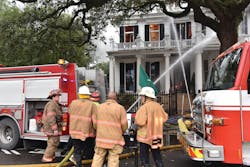Those of us in leadership roles are all too familiar with the challenge of balancing the needs, motivations and interests of many people within and outside of our organization. This challenge especially comes to light when we are tasked with rewarding some and not others.
Wants and expectations
We recently completed a lieutenant promotional process where the candidates all did well, yet there weren’t open positions for all of them. The organization only had two openings and five candidates. There are plans to give those unsuccessful candidates the opportunity to develop more skills and demonstrate why they should be promoted next time and they will remain on the promotion-eligible list. Doesn’t sound bad, right? Wrong. I have heard from different circles that one of the people not promoted felt that they were deserving of the promotion over those who were. This candidate reportedly stated they were “robbed” of the promotion, and that due to the fact they had wanted this for more than three years, they should have been promoted. Picture how that conversation went with peers, superiors and family members. You can easily hear the whining tone in the voice. This person wanted a reward—a cookie, so to speak—for their efforts.
Those of us in leadership roles must be aware of this in our organization. Each member of our organization wants their own “cookie”—whether it’s a promotion, new equipment or a reward—and, many times, can become jealous when things don’t go their way. As leaders of all ranks, it is imperative to understand each person’s driving factors and work with them, not against them. We must be flexible enough to adjust to the varied interests so as to drive the organization into a positive future both inside and out.
Different rewards for different people
Take a moment to think back to your personal experiences in the service. Did you always get what you wanted? Did you see something someone else had and wanted to have one for yourself? Did you let either of these desires motivate you to do more or take action to get that “cookie”? Throughout our careers, we see this scenario play out time and time again. We are all big kids, in a sense, and in the end, we want the cool toy, be it the new apparatus, the new set of turnouts, the new position, you name it. Sometimes this isn’t a bad thing; these desires drive us to excel and healthy competition is good. If not managed properly, however, these desires can also be destructive for our organization.
Several years ago, an organization was going through change in deployment and station assignments. The chief responsible for managing the re-deployment wanted to be inclusive and have the group potentially impacted by the change discuss how to deploy. There was discussion as to the goals of the deployment, the resources available to be deployed and the data behind current responses. The group came up with multiple options to deploy the equipment and people. The whole discussion ended in a very good place to meet the needs of the organization while adding responses to all those working structure fires for two of the units. How could this be a bad thing? The two units that were to respond on all the working structure fires would be staffed in a rehab unit. Those two companies would exchange their older fire engine with a brand-new rehab. This was met by some with great consternation. They didn’t want to “lose” their engine even if it meant more calls and knowing that they would be working the job in addition to rehab. It came down to protection of their own interests. This is common when change is made.In another example, two members are talking about how one of them was just given an opportunity to help with the upcoming training academy. The other person shares how they were promised that role last year and that it wasn’t fair that their peer was given the opportunity instead. Situations like this can create an environment of stress and potential harassment. These are very real feelings and dilemmas that leadership in all organizations face and must address.
Let’s start with how to address the perceived loss of apparatus status. Some will say “deal with it” by not dealing with it. That is one answer, yet I wouldn’t suggest it. Not addressing the concerns will only let them fester and manifest at the most inopportune time. This is an example that must be addressed directly and immediately. Take the crew aside and guide them through the collectively agreed upon decision; the one they participated in and agreed to. Ask them what they felt was missed or if the premise was wrong. Let them explain the why behind their feelings. In the end, you need to get them to try the new approach.
The other situation is more difficult to address mostly because it is anchored in personal emotion of inequality. If the organization simply picks people for positions based on what the leadership “feels” is the best fit, we will forever be dealing with this issue. The bottom line is that this is a form of cronyism. How do we stop it? We make sure we have fair, competitive processes that are anchored on objective standards and requirements and not on subjective soft opinions and feelings. Going forward, if someone says the reason a candidate received a promotion or other reward is because they were the “right fit,” you should immediately question the results. Most of the time, the “right fit” opens the organization up for lawsuits secondary to discrimination. I know, some of you are saying that intuition and years of experience set you up to be better at recognizing the “right” person. Going through a process, however, is the only way to assure fairness and validation of our gut feelings. We need to select the best person for the position based on set criteria. Addressing the lack of transparency or communication is fairly easy. Communicate with the organization and those directly involved. Demonstrate the process that was used and criteria involved. To support the member who feels slighted, find an opportunity for him or her to demonstrate their individual skillset in future scenarios. Our job as leaders is to bring out the best in others and support their success. Find opportunities to let your members shine. In other words, help them find their own cookie.
Beyond the firehouse
So far we have talked about internal reactions to various issues inside the organization. Now let’s take a moment to look outside the firehouse. The community and the different factions within the community have their own wants, desires and motivations. City departments and special districts both have constituents that expect delivery of services specific for them. Are we setting those expectations ourselves or are they being set for us? I argue that they are being set for us. Recently I was part of a conversation where my organization was discussing the growth outside our current boundaries while annexing a town to which we provide contract services. One side was talking about how both the annexation and boundary expansion would help the sustainability of the district through additional revenue. Another person mentioned how the services could be coordinated for better service to the community and we could leverage the power of purchasing additional equipment at a discount because of volume. I think many of us would agree that these are very positive and compelling reasons; the counter came, however, in the terms of “cookie equality.” With there being a greater population in the main part of the district, the question was raised, “What about us in the outer areas?” These areas are populated by people who wanted to be outside of the urban/suburban areas while expecting the same level of services. They expected to have the same type of support and service as the denser populated areas. Rest assured that if organizational leadership can’t answer how their cookie is the same or better than the others, the populace in the outer areas won’t support the plans of the district.
We need to set clear, measurable expectations for the communities we serve with input from them. Many of our constituents obtain their information from movies and television, and we all know how realistic those are. It isn’t realistic for a fully volunteer department in the middle of Alaska to provide the same level of services as the Washington, D.C. Fire and EMS. They can only serve their community based on the resources available. Having an open dialog with the community can define those expectations and realized funding streams. Once clear expectations are established, they can be written into goals and objectives.
My district protects a number of islands in northwest Washington State. In order to create a semblance of equality, i.e. a similar cookie, we are looking at allocating funds to purchase an additional boat for response to the other outer islands while simultaneously adding education programs for community risk reduction that will help those residents be safer from both fire and medical emergencies. Dialog thus far has shown that this approach is received positively from existing residents as well as the potential additional residents from other areas not currently served.
Put lessons into practice
Leaders of organizations must to be ready to meet the needs of the wide variance of individuals within their firehouse and community. Once you discover what the individual and community needs are, you will be on your way to having a great organization complete with happy and fulfilled members and residents. Be safe and lead with courage.
About the Author

Norvin Collins
Norvin Collins was selected as the Fire Chief for San Juan Island Fire & Rescue in Oct. of 2018. The District protects 55 sq. miles and the population of approx. 9,000 residents on San Juan Island as well as living on Brown and Pearl Islands along with the DNR land on all 172 named Islands within San Juan County. 500,000 visitors populate San Juan Island throughout the course of the year for the natural beauty the area holds. The District is a combination Emergency Services Organization with 8 full-time staff and 50 Paid-On-Call volunteers.
Chief Collins was selected as Sauvie Island Fire District's first paid fire chief in Dec. of 2010. He served Sauvie Island Fire District as a paid Chief along with an administrative assistant, facilities/apparatus manager, and 35 volunteer members; serving approximately 36 square miles of predominately rural and Oregon State land with 1600 citizens and portions of two counties and receives 1.5 million visitors a year.
Norvin Collins served as a Division Chief for Tualatin Valley Fire & Rescue where he worked from 1994 through 2012 having held the ranks of firefighter/paramedic, lieutenant, captain, battalion chief, and division chief. Additionally, Norvin served as the District’s Volunteer Coordinator for five years overseeing the volunteer operations for Oregon’s largest combination department.
Chief Collins presents nationally on a variety of leadership and development topics for the International Association of Fire Chiefs' (IAFC) Volunteer and Combination Officers Section (VCOS), State Chief’s Associations, Elected Officials Conferences, and other local and national organizations. Norvin is an Elected Board member for the VCOS and holds positions on the VCOS national conference planning committees, a Planning Section Chief for a regional Type III Incident Management Team, and a member of numerous committees both internal and external to the fire service.
Chief Collins holds a B.S. in Fire Administration, a M.S. in Psychology, and EFO credentials through the National Fire Academy. He holds numerous fire and medical operational certifications as well as having published papers and articles on various fire service topics.

